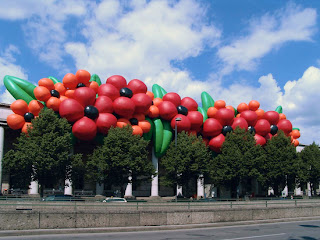Artist References from Session 6
In contemporary art textiles and materials have been used in various ways within sculpture, installation, costume, film and theatre. Because of its manipulative characteristics and easy production fabric is easy to dye, cut, stretch, sew, fold and transport and it is a popular consumer item. Contemporary, experimental use of textiles replaces Arts and Crafts methods such as knitting, crochet, embroidery and dressmaking, transforming and reinventing a medium that traditionally carries strong feminine and domestic associations.
Christo and Jeanne Claude
Christo and Jeanne Claude started working together in 1958. They are commonly known for their use of material to wrap up famous landmarks or buildings. Their most well known 'wrappings' are the Reichstag in Berlin (a government building) and the Pont-Neuf bridge in Paris. Their process of wrapping gives the architecture or object a new identity and transforms its appearance within its surroundings. The ephemeral (lasting for a very short time) wrapping process becomes the art-work itself.
In contemporary art textiles and materials have been used in various ways within sculpture, installation, costume, film and theatre. Because of its manipulative characteristics and easy production fabric is easy to dye, cut, stretch, sew, fold and transport and it is a popular consumer item. Contemporary, experimental use of textiles replaces Arts and Crafts methods such as knitting, crochet, embroidery and dressmaking, transforming and reinventing a medium that traditionally carries strong feminine and domestic associations.
Christo and Jeanne Claude
Christo and Jeanne Claude started working together in 1958. They are commonly known for their use of material to wrap up famous landmarks or buildings. Their most well known 'wrappings' are the Reichstag in Berlin (a government building) and the Pont-Neuf bridge in Paris. Their process of wrapping gives the architecture or object a new identity and transforms its appearance within its surroundings. The ephemeral (lasting for a very short time) wrapping process becomes the art-work itself.

Do Ho Suh
Do ho Suh's artwork is linked with memory. In an act to overcome home sickness when moving from Japan to New York he meticulously measured the interior of his room in Tokyo and replicated it using fabric. Suh's installations interact with gallery spaces in a surreal way provoking spacial and psychological themes. The flat-packed nature of his installation gives an added temporality and delicacy to his work that is enhanced by the use of netting.
Cosima von Bonin
Prolific German artist Cosima von Bonin produces work spanning painting, sculpture, textiles, installation, film and performance. She often collaborates with fellow artists, musicians and writers, redefining the definition of the artist by taking on various different roles. Textiles play an important part in von Bonin's work. She has appropriated unusual textile materials such as felt, dishcloths and wool blankets in conceptually complex works, exploiting and challenging the heavy associations that these bring to mind.
Sarah Lucas
Louise Bourgeouis
Fabric is often used as a sculptural material. Louise Bourgeois and Sarah Lucas' human like forms demonstrate the flexibility that material lends itself to the artist. In both these works (above) Lucas and Bourgeois use a certain hosiery material (stocking and tights textiles) which associates their sculptures with the feminine connections that textiles has within history and tradition.
Joana Vasconcelos (below) uses traditional methods to create weird and colourful objects within her artwork. Its presence in a contemporary gallery space references time where the audience can follow the history of textile techniques from traditional to modern textile production.

Joana Vasconcelos
Claes Oldenburg
Making large objects out of textiles adds a little humor to the art world. Claes Oldenburg creates large fabric replicas of domestic and consumer objects. These sculptures reference theatre or film props that divide up an exhibition space and allow the audience to become aware of their presence in relation to space and object.
Paul McCarthy
In public sculpture textiles are commonly used because of its durable and manipulative nature and it can be easily mass produced using CAD design. Paul McCarthy is one artist who has experimented with creating large and humorous fabric public sculptures. These gigantic objects are integrated within public environments which emphasize scale and space.
Edwina Ashton
Contemporary and quirky British artist, Edwina Ashton likes to create funny creatures in her work which she then uses as characters in her films or in exhibitions. Her work often uses fictional references and story telling and transcends the boundaries between sculpture, installation, theatre and performance.










